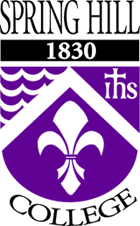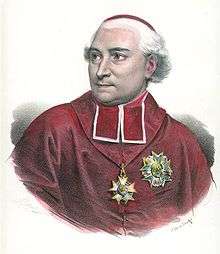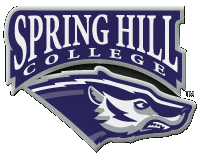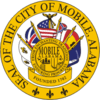Spring Hill College
 | |
| Latin: Collegium Fons Collis | |
| Motto | In Colle Exaltatus Fons Sapientae (Latin) |
|---|---|
Motto in English | A spring of wisdom is he who was lifted up on the hill |
| Type |
Private Nonprofit Coeducational Liberal Arts |
| Established | 1830 |
| Affiliation | Roman Catholic (Jesuit) |
| Endowment | US $19.1 million[1] |
| President | E. Joseph Lee II, Ph.D. (Interim President) |
Academic staff | 79 full-time |
| Students | 1,439 |
| Undergraduates | 1,257 |
| Postgraduates | 182 |
| Location | Mobile, Alabama, USA |
| Campus |
Urban - 400 acres (161.9 ha) 32 buildings 18-hole golf course |
| Colors | Purple and White |
| Athletics | NCAA DII SIAC |
| Nickname | Badgers |
| Affiliations | AJCU |
| Sports |
19 varsity sports teams[2] (8 men's and 11 women's) |
| Mascot | Badger |
| Website | www.shc.edu |
Spring Hill College is a private, liberal arts college in the Catholic, Jesuit tradition. Founded in 1830 and located on the Gulf Coast in Mobile, Alabama, the College is accredited by the Southern Association of Colleges and Schools. It was founded in 1830 by Michael Portier, Bishop of Mobile. It was the first Catholic college in the South, is the fifth-oldest Catholic college in the United States, and is the third-oldest of the 28-member Association of Jesuit Colleges and Universities. In 2010, U.S. News & World Report reported that Spring Hill College ranked 14th among the top colleges in the South offering both bachelor's and master's level degrees.[3]
The Spring Hill academic calendar is divided into two semesters, a fall semester of 15 weeks beginning at the end of August and ending before Christmas, and a spring semester of 15 weeks beginning in early January and ending in early May. There are May and June mini-sessions, and summer school during June and July.
History

Spring Hill College was founded by the first bishop of Mobile, Michael Portier, who was from France. After purchasing a site for the college on a hill near Mobile, Bishop Portier went to France to recruit teachers and raise funds for the new college. Portier recruited two priests and four seminarians from France to staff the school. A friend of Portier, Cardinal Joseph Fesch, Archbishop of Lyons, was a major benefactor to the fledgling College, donating his philosophical and theological library and various works of art. Pauline Jaricot, founder of the Society of the Propagation of the Faith, donated 38,000 francs, an enormous sum in those days.
The bishop himself taught theology to the ecclesiastical students, who numbered six the first year. Upon his return from France, Portier rented a hotel next to the college grounds and started the first semester on May 1, 1830, with an enrollment of thirty students. On July 4 of the same year, the bishop laid the cornerstone of the first permanent building. It stood on the site of the present Administration Building and opened for classes in November 1831. Spring Hill is the oldest institution of higher education in Alabama and among the oldest colleges in the South. It is the third-oldest Jesuit college in the United States.[4][5]

In 1836 the governor of Alabama, Clement C. Clay, signed a legislative act that chartered the College and gave it "full power to grant or confer such degree or degrees in the arts and sciences, or in any art or science as are usually granted or conferred by other seminaries of learning in the United States." This power was used in the following year, 1837, when four graduates received their degrees.
The first two presidents of the College were called away to be bishops, one to Dubuque, Iowa (Bishop Mathias Loras), the other to Vincennes, Indiana (Bishop John Stephen Bazin). The third president, Father Mauvernay, died after a brief term of office. Bishop Portier transferred the College, first to the French Fathers of Mercy, and next to the Society of Jesus and Mary, but both groups lacked teaching and administrative experience.[6]
He persuaded the Fathers of the Lyonnais Province of the Society of Jesus (Jesuits) to take possession of the College.[6] The new regime was inaugurated with Father Francis Gautrelet, S.J., as president in September 1847. Since that time the institution has continued under Jesuit direction.[4]
Many boys were sent to Spring Hill during the American Civil War as they neared the draft age. But numerous students wanted to be part of the war effort. The college eventually formed two military companies. Some of Spring Hill's Jesuit fathers became chaplains for the Confederacy. A recruiter tried to conscript all forty of the Jesuit brothers at the college into the Confederate Army. The College President Gautrelet dispatched an urgent message to the assistant secretary of war in Richmond, who granted a temporary reprieve of the brothers' conscription.[6]
During the Reconstruction era, the College recruited students from among the sons of Central American and Cuban leaders. Following student complaints that Spanish was challenging the dominance of English on the campus, the Jesuits organized a Spanish–American league.[6] In 1869 a fire destroyed the main building. Students and faculty had to relocate for a time to St. Charles College in Grand Coteau, Louisiana. Bishop John Quinlan and other benefactors assisted in rebuilding the College, which reopened at Spring Hill before the year's end.[4]
As the enrollment increased, Quinlan Hall, St. Joseph's Chapel, the Thomas Byrne Memorial Library, and Mobile Hall were erected. In 1935, the high school, which had been a unit distinct from the College since 1923, was discontinued. In the space vacated by the high school, the Jesuit House of Studies was opened in 1937, and the Scholasticate of the Sacred Heart opened on a site adjoining the College a few years later.[4]
After World War II, a great influx of veterans taxed the facilities of the College, which erected numerous temporary buildings on the campus to handle the new students. At the request of Archbishop Thomas Joseph Toolen of Mobile, the College became co-educational in 1952. In 1954 the College accepted African-American students into all departments, before the United States Supreme Court ruling in Brown v. Board of Education (1954) that segregation in public schools was unconstitutional. Mrs. Fannie E. Motley was the first black graduate from the institution in 1956.[4]
Spring Hill College was a leading institution in Alabama to press for racial equality. It was praised by civil rights leaders such as Dr. Martin Luther King, Jr., who referred to the college in his 1963 "Letter from Birmingham Jail." He noted that the College was one of the first Southern schools to integrate. Spring Hill received threats from those opposed to the civil rights movement and integration.[4]
On the night of January 21, 1957, a dozen or more darkened cars entered the main avenue of the college. KKK members tried to set up a kerosene-soaked cross outside Mobile Hall, a dormitory. They were unaware that they were there during finals week. Most of the white, male residents were still awake, studying for exams, and several heard the hammering. Once alerted, students streamed from both ends of the building carrying whatever items were handy as weapons – golf clubs, tennis rackets, bricks, a softball bat – and put the panicked Klansmen to flight. A KKK contingent returned the next night, burning a cross at the gate of the College before students reacted. The following day, a group of students – male and female – hanged a Klansman in effigy at the College gate, with a sign reading, "KKKers ARE CHICKEN."[7]
Following Hurricane Katrina's widespread destruction along the central Gulf Coast in 2005, Spring Hill accepted 117 students, the majority of them from Loyola University in New Orleans, a brother Jesuit institution, for the remainder of the year.[8]
Student body
More than 1,400 students study at Spring Hill College each year, of which more than 70% are from outside Alabama. The student body is 38% male and 62% female; 90% of the freshman class and 75% of the total student body live on campus.
The student-faculty ratio is 13:1, and the average class size is 17. Of faculty members, 87% hold doctorates or the highest degrees in their fields. More than one-third of graduating students continue their education at graduate or professional school.
Curriculum
Spring Hill College offers undergraduate students bachelor's degrees through a variety of majors. The available departments include the Division of Business, the Communications/Arts Division, International Studies, Interdivisional Studies, Language and Literature Division, Nursing, Philosophy and Theology, Sciences Division, Social Sciences Division, Teacher Education Division, and lastly, the Pre-Professional Programs. Each of these divisions offers a variety of concentrations from which students can choose majors and minors.[9]
Spring Hill has an academic center in Bologna, Italy; it also accepts study abroad students from other colleges and universities.
Areas of concentration in graduate programs include Master of Business Administration, Teacher Education, Master of Liberal Arts, Master of Science in Nursing, Master of Theological Studies, Master of Pastoral Studies, and Master of Arts in Theology. Certificate programs are offered in theology and ministry. Theological programs are offered at the main campus as well as at off-campus locations in Atlanta, Georgia; Birmingham, Alabama; and Jackson, Mississippi. An online master's degree program for a Master of Science in Nursing is offered that combines online and offline nursing experience.[10] Through the Cooperative Center for Study Abroad consortium, students may arrange for study abroad programs and internships in England, France, Ireland, Spain, Italy, and Mexico.[9][11]
Campus
The Spring Hill College campus is located in the Spring Hill neighborhood of Mobile, Alabama. The college has remained on the same campus that Bishop Portier purchased in 1830. A number of its structures are listed on the National Register of Historic Places. They include the Sodality Chapel (built 1850); the Spring Hill College Quadrangle, comprising the Administration Building (1869), St. Joseph's Chapel (1910), and four other structures; and Stewartfield (1849).[12]
Other notable feature of the campus is the Avenue of the Oaks, where graduation traditionally occurs. An 18-hole golf course is used by the team and other students. The historic Administration Building renovation was completed in 2008. It was renamed as "The Gregory F. Lucey, S.J. Administration Center", after the College's 38th President.[13]
Student life
Clubs and organizations
There are over fifty student-run clubs and organizations at Spring Hill College. They include community service clubs, ministry organizations, athletic and academic clubs.
| Academic | Athletic | Ministry/Service | Other |
|---|---|---|---|
| Alpha Sigma Nu Club (Jesuit Honor Society) | Rugby Club | Knights of Columbus | Delta Alpha Chi |
| Theta Alpha Kappa Club (Honor Society of Religious Studies and Theology) | Men's Volleyball Club | Knights of Columbus Ladies Auxiliary | Anime Club |
| Sigma Tau Delta Club (English Honor Society) | TAG3 | Badger Book Club | |
| Pi Sigma Alpha Club (Political Science Honor Society) | Ultimate Frisbee Club | SHAPe Community | |
| Math Club | Habitat for Humanity | ||
| Philosophy Club | |||
| English Club | |||
| Delta Mu Delta (Business Honor Society) | |||
| History Club | |||
| Psi Chi (Psychology Honor Society) | |||
| Phi Sigma Tau (Philosophy Honors Society) | |||
| Lamda Pi Eta (Communications Honor Society) | |||
Greek life
Seven national Greek organizations are represented on campus.
Sororities:
Fraternities:
The Greek organizations participate in a "deferred recruitment" process, meaning that the formal recruiting activities occur at the beginning of the spring semester. This is in contrast to many colleges where recruitment takes place at the beginning of the fall semester.
Intramural sports
Spring Hill College has a student-run intramural program. The following sports are offered:
- Sand volleyball (4-on-4 Co-Rec, up to 8 on team)
- Basketball (5-on-5)
- Soccer (6-on-6, including the goalie, up to 10 on team)
- Flag Football
Athletics

The school is part of the National Collegiate Athletic Association (NCAA) Division II, and primarily competes in the Southern Intercollegiate Athletic Conference (SIAC). Men's sports include baseball, basketball, bowling (2013), cross country, golf, soccer, tennis, and track and field. Women's sports include basketball, bowling (2013), cross country, golf, soccer, softball, tennis, track & field, competitive cheer & dance, and volleyball.[2] The mascot is the badger.
The Spring Hill football team played its first game in 1900, but was disbanded in 1941.
Spring Hill College has maintained a baseball team since its first intercollegiate play in 1889.[14] Currently, the Spring Hill College baseball team plays its home games at Stan Galle Field ("The Pit"), the oldest continually used college baseball field in the country.[15] Notable baseball alumni include Blake Stein, former pitcher for the Pittsburgh Pirates and Kansas City Royals, and Jim Hendry, former general manager of the Chicago Cubs.
Spring Hill has moved its college rugby program under the athletic department to provide more resources and to help boost admissions to the school. The rugby program is fully funded, overseen by the athletic department, and provides scholarships for men and women.[16] Spring Hill rugby competes in the small college division.
The school formerly competed in the Gulf Coast Athletic Conference (GCAC). On July 12, 2013, Spring Hill was accepted by the NCAA to begin its process towards joining the NCAA Division II.[17] Spring Hill joined the Southern Intercollegiate Athletic Conference beginning in Fall 2014, becoming the first non-HBCU to join the conference.[18]
On August 11, 2014, the Gulf South Conference announced that Spring Hill would join the conference as an affiliate member competing in men's and women's soccer and women's golf. Spring Hill began to compete in full schedules starting in 2014, but it was not eligible for post-season play until the 2015-2016 school year.[19]
Controversy
On July 27, 1963, Lee Harvey Oswald spoke at Spring Hill about life in the Soviet Union; his speech was considered controversial because of strong opposition in the United States to communism during the Cold War. His lecture took place months before he assassinated President John F. Kennedy on November 22, 1963.[20]
Notables
Alumni
- Nick Bollettieri, 1953 tennis coach.
- Armand Brinkhaus (Attended c. 1954-1956), politician, served in both houses of the Louisiana State Legislature, from 1968 to 1996.[21]
- Philip J. Carey, 1940, Illinois state senator and judge[22]
- Jeremiah Denton, career U.S. Navy officer, admiral; held as an American POW during the Vietnam War.
- Olaf Fink, politician and member of the Louisiana State Senate from 1956 to 1972; New Orleans educator.[23]
- Patrick J. Geary, medieval historian and professor at the Institute for Advanced Studies.
- Jim Hendry, executive with the New York Yankees; played baseball while student at Spring Hill.
- Alexis Herman, U.S. Secretary of Labor.
- Miller Reese Hutchison, 1895, noted inventor of the first electric hearing aid and worked at the Edison Laboratory.
- Jo Ann Jenkins, (Class of 1980), CEO American Association of Retired Persons; Chief Operating Officer of the Library of Congress.
- Stephen Karopczyc, 1965, U.S. Army first lieutenant awarded the Medal of Honor.
- Patricia Krenwinkel, student at the college for less than a semester; went to California and joined "The Family", the followers of the murderer Charles Manson.
- Joe Langan, 1951, Alabama state senator, Finance Commissioner for four terms and Mayor of Mobile, Alabama; credited with keeping peace during the civil rights years and forming alliances with black leaders, especially John LeFlore.[24]
- Stephen Mallory, Secretary of the Navy for the Confederate States of America.
- Dominic Mauncy, 3rd Bishop of Mobile.
- Colman McCarthy, leading peace educator, founder of the Center for Teaching Peace, and columnist at The Washington Post.
- Samuel D. McEnery, Governor of Louisiana; Louisiana Supreme Court; United States Senator from Louisiana.
- Paul Morphy (1855), aged 18 at graduation; considered to have been the strongest chess master of his time, as well as the first recorded chess prodigy in history.[25] In 1957 a centennial monument dedicated to Morphy's 1857 victory in the First American Chess Conference was erected behind Mobile Hall, presented by the Log Cabin National Chess Affiliation (now defunct).
- Jean-Paul Morrell (2001), New Orleans lawyer and politician; served in both houses of the Louisiana State Legislature.[26]
- John T. Schuessler, retired chairman of the board, CEO, and president of Wendy's International, Inc..
- Todd Schuler (1999), Maryland State Delegate (D).
- Blake Stein (2005), baseball pitcher for the Pittsburgh Pirates in the National League.
- Dana Veth (2012), professional Bahamian soccer player.
- T. Semmes Walmsley, mayor of New Orleans.
- Arthur C. Watson (Class of 1930), Natchitoches, Louisiana, lawyer, civic leader, politician, and philanthropist.
Faculty
- Edward Troye, mid-19th century artist; taught French and drawing at the college from 1849 to 1855.[27]
- Magda B. Arnold, American psychologist who developed the appraisal theory of emotions; taught at Spring Hill from the early 1970s until retirement in 1975.


Alabama State Senator Ann Bedsole of Mobile was a Spring Hill College trustee.[28]
Bishop Michael Portier, D.D., first bishop of Mobile, founded Spring Hill College on May 1, 1830. Presidents of the college:
- Bishop Mathias Loras, D.D. 1830-1832
- Bishop John Stephen Bazin, D.D. 1832-1835
- Peter Mauvernay, 1835-1839
- Bishop John Stephen Bazin, D.D. 1839-1840
- Dominic F. Bach, S.P.M. 1840-1842
- Claude Rampon, 1842-1844
- J. P. Bellier, C.J.M. 1845-1846
- Albin Desgaultieres, 1846
- Francis de Sales Gautrelet, S.J., 1847-1859
- Anthony Jourdant, S.J., 1859-1862
- Francis de Sales Gautrelet, S.J., 1862-1865
- Aloysius Curioz, S.J., 1865-1868
- John Montillot, S.J., 1868-1875
- Dominic Beaudequin, S.J., 1875-1880
- John A. Downey, S.J., 1880-1883
- David McKiniry, S.J., 1883-1887
- James Lonegan, S.J., 1887-1896
- Michael S. Moynihan, S.J., 1896-1899
- William Tyrrell, S.J., 1899-1907
- Francis X. Twellmeyer, S.J., 1907-1913
- Edward Cummings, S.J., 1913-1919
- Joseph C. Kearns, S.J., 1919-1922
- Michael McNally, S.J., 1922-1925
- Joseph M. Walsh, S.J., 1925-1932
- John J. Druhan, S.J., 1932-1938
- W. Doris O'Leary, S.J., 1938-1946
- W. Patrick Donnelly, S.J., 1946-1952
- Andrew C. Smith, S.J., 1952-1959
- A. William Crandell, S.J., 1959-1966
- William J. Rimes, S.J., 1966-1972
- Paul Smallwood Tipton, S.J., 1972-1989
- Donald I. MacLean, S.J., 1989
- William J. Rewak, S.J., 1989-1997
- Gregory F. Lucey, S.J., 1997-2009
- Richard Salmi, S.J., 2009-2013
- Gregory F. Lucey, S.J., 2013-2015
- Christopher P. Puto, Ph.D., 2015–2018
- Christopher Viscardi, S.J., 2018 (President Pro Tem)
- E. Joseph Lee II, Ph.D., 2018 - Present (Interim President)
References
- ↑ "Regional Universities West". US News & World Report. 2011. Retrieved October 6, 2012.
- 1 2 "Spring Hills College Athletics".
- ↑ "Spring Hill College". Retrieved 25 September 2014.
- 1 2 3 4 5 6 Boyle, Charles J. (2004). Gleanings from the Spring Hill College Archives. Mobile: Friends of the Spring Hill College Library. ISBN 1-887650-24-5.
- ↑ "The Mission Statement of Spring Hill College". Spring Hill College. Archived from the original on 21 August 2011. Retrieved 4 April 2010.
- 1 2 3 4 Charles Stephen Padgett (22 February 2007). "Spring Hill College". Encyclopedia of Alabama. Retrieved 4 April 2010.
- ↑ McDermott, Jim S.J. (April 16, 2007). "A Professor, a President and the Klan". America, The National Catholic Weekly. New York.
- ↑ Lorenz, Alfred Lawrence. "Katrina Strikes and Southern Jesuit Colleges Survive" (PDF). Conversations on Jesuit Higher Education. National Seminar on Jesuit Higher Education. 29 (Spring 2006). Retrieved 7 April 2010.
- 1 2 "Undergraduate Divisions and Programs". Spring Hill College. Archived from the original on 11 October 2007. Retrieved 4 April 2010.
- ↑ "Off Campus Programs". Spring Hill College. Retrieved 4 April 2010.
- ↑ "Study Abroad Programs". Career Services at Spring Hill College. Spring Hill College. Retrieved 4 April 2010.
- ↑ National Park Service (2009-03-13). "National Register Information System". National Register of Historic Places. National Park Service.
- ↑ "News and Events". Retrieved 25 September 2014.
- ↑ "Badger Athletics". Spring Hill College. Retrieved 4 April 2010.
- ↑ "Athletic Facilities". Spring Hill College. Retrieved 4 April 2010.
- ↑ "Scholarship, Varsity Options Increase". rugbymag.com. December 19, 2012. Archived from the original on January 28, 2013.
- ↑ "Archived copy". Archived from the original on 2013-07-18. Retrieved 2013-07-27.
- ↑ "Spring Hill accepted into NCAA Division II; plans move from NAIA's SSAC to SIAC". AL.com. Retrieved 25 September 2014.
- ↑ "Badgers Join Gulf South Conference in Soccers and Women's Golf". Spring Hill College. Retrieved 2014-08-11.
- ↑ "Summary of a Speech by Lee Harvey Oswald, Jesuit House of Studies, Spring Hill College Mobile, Alabama, July 27, 1963".
- ↑ "Living Legends: Armand Brinkhaus". acadiamuseum.com. Retrieved May 23, 2014.
- ↑ 'Illinois Blue Book 1961-1962,' Biographical Sketch of Philip J. Carey, pg. 202
- ↑ "Fink, Olaf J." A Dictionary of Louisiana Biography by the Louisiana Historical Association. Archived from the original on September 23, 2010. Retrieved July 7, 2015.
- ↑ Thomason, Michael (2001). Mobile : the new history of Alabama's first city. Tuscaloosa: University of Alabama Press. ISBN 0-8173-1065-7.
- ↑ "Speaking about Fischer..." 4 November 2006.
- ↑ "Senator Jean-Paul "JP" Morrell (District 3) Biography". senate.la.gov. Retrieved April 23, 2015.
- ↑ Dumas Malone, ed. (1964). "Part 1". Dictionary of American Biography. X. New York: Charles Scribner's Sons.
- ↑ "Bedsole, Ann". ourcampaigns.com. Retrieved May 28, 2014.
External links
![]()
Coordinates: 30°41′39″N 88°08′13″W / 30.69430°N 88.13682°W
